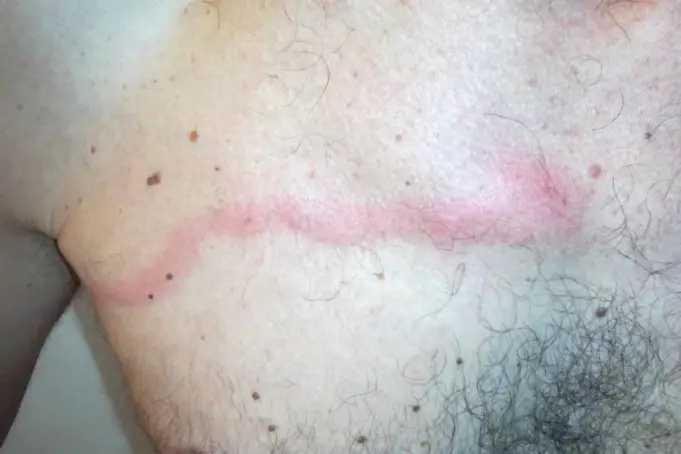Mondor’s disease- a rare medical condition of chest pain. Mondor’s disease is a condition that was named in 1939 by a French Medical Practitioner and Professor of Clinical Surgery in Paris called Henri Mondor (1885-1962).
He initially described the Mondor disease as a syndrome of sclerosing superficial thrombophlebitis of the veins of the anterior thoracic wall- the chest region of the body.
Thrombophlebitis is an inflammatory process that causes blood clots to form and block one or more veins, the affected vein might be near the surface (superficial thrombosis) or deep within the muscle (deep vein thrombosis).
The most commonly involved vessel is the superior epigastric vein forming a palpable cord in the lower outer quadrant of the breast, also known as the Mondor’s cord.
This rare clinical condition has also been reported affecting the superficial penile veins. Mondor’s disease been a rare form of chest pain is often underdiagnosed due to lack of awareness as chest pain been one of the common presenting symptoms for many medical conditions encountered in an emergency department.
For women, it is most common as it can affect any muscle of the breast but most commonly affects those on the outer side of the breast or under the nipple. But it does not cause breast cancer and cannot be drawn as a symptom of breast cancer.
What can cause Mondor’s Disease?
The primary cause of mondor’s disease is still very unclear. However, some conditions can be associated to the disease. They are:
- Severe injuries or blows to the breast
- Wearing of tight clothing, though this is rare
- Strenuous and vigorous exercises
- Mondor’s disease can also be an after effect of breast surgery or breast reconstruction. When it occurs in the armpit after a breast cancer surgery, it is termed cording or axillary web syndrome.
What are the Symptoms to watch out for in Mondor’s Disease?
- Symptoms of the Mondor’s disease cannot be missed, the condition present itself as a long narrow cord under the skin, which is often red for light toned individual and very painful to touch. As times passes, the pain wears off and the narrow cord becomes a tough band where the skin becomes pulled in.
When the arm of the affected side is raised, the skin over the breast is stretched and a shallow groove can be seen over the cord, making it impossible to miss.
- Mondor disease as earlier stated is a rare clinical entity affecting more women than men. Patients may develop lesions in sensitive areas such as the breast or penis. Most patients may feel embarrassed or afraid to discuss their symptoms with a physician. Having well informed health care team with providers like nurses, technicians and physicians aware of this rare clinical disease is vital to identifying patients at risk for more sinister diagnoses.
How does a Medical Centre diagnose Mondor’s disease?
A general medical practitioner examines the entire chest region and is likely to refer you to a breast clinic where you will be directed to a specialist nurse or doctor. After thorough examination, this specialist may be able to confirm the condition as Mondor’s disease.
Otherwise, you will be requested to undergo a breast x-ray test (mammogram) and an ultrasound scan, which uses high frequency sound waves to produce an image of your internal breast region. All these are to help the specialist diagnose correctly.
Mondor’s Disease and Breast Cancer. Any Connection?
There is no medical proof to ascertain that having mondor’s disease connotes having breast cancer and vise versa. Also, it does not increase the risk of developing breast cancer either.
However, it is still medically important to be breast aware and swiftly go back to the doctor if you notice any other changes in the breast, regardless of the period space after a diagnosis of mondor’s disease was conducted.
How can Mondor’s disease be treated?
Treatment for mondor’s disease is not necessarily required; after all it gets better by itself. The pain that accompanies mondor’s disease only last for a few days (in some cases, maybe weeks), but the cord that appears can remain for several months before it fades away.
However, in managing the condition, pain relievers and anti-inflammatory medications; either tablets or gel (rubbed on affected areas) may be advised to ease the healing process. Warm compress held against the area may also be of efficient help.
Resting the arm may also relieve discomfort and wearing of well-fitting clothing like bra for women.
Complications in Mondor’s disease
The mondor’s disease condition and symptoms may not only be wrapped around the chest region only. In 1955, the Braun-Falco of Paris described dorsal phlebitis of the penis within the context of generalized phlebitis.
The first reported case of an isolated superficial thrombophlebitis of the dorsal vein of the penis was recorded by Helm and Hodge in 1958 and the condition was named as Penile Mondor’s Disease (PMD).
PMD has been associated in time past with sexually transmitted infections (STI), however it is still unclear whether the link is causal or rather that increased sexual activity in this cohort is a coincidental association.
Conclusion
Mondor’s disease is not considered a differential diagnosis for chest pain due to lack of awareness of the medical condition. Creating awareness for mondor’s disease via undergone cases would help to cut down unnecessary investigations and valuable time and resources spent in emergency wards, and it will help to identify a serious underlying cause especially carcinoma of the breast at its early stage.
Sources;
- Mondor disease; https://emedicine.medscape.com/article/1087099-overview
- Mondor disease; https://radiopaedia.org/articles/mondor-disease












